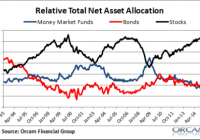5 Best Rated Diversified Bond Mutual Funds
Fixed-income securities are the preferred choice of investors who are ready to forgo capital growth for regular income flows. The expense involved in creating such a portfolio of bonds from different categories may be quite considerable. This is why most investors select mutual funds since they are a convenient and affordable method of investing in bonds. Also, diversified bond funds further reduce the risk involved by holding securities from different sectors. A downturn in any one sector therefore only has a partial effect on the fund’s fortunes. Below we will share with you 5 top-rated diversified bond mutual funds. Each has earned a Zacks #1 Rank (Strong Buy) as we expect these mutual funds to outperform their peers in the future. Nuveen Preferred Securities A (MUTF: NPSAX ) seeks high level of current income. NPSAX invests a major portion of its assets in preferred securities. The advisor invests a minimum 25% of its assets in the preferred securities of companies primarily involved in financial services. NPSAX invests a minimum half of its assets in securities rated investment grade. The Nuveen Preferred Securities A is non-diversified fund and has returned 4.4% over the past one year. NPSAX has an expense ratio of 1.07% as compared to category average of 1.38%. Columbia Strategic Income A (MUTF: COSIX ) invests in three categories of debt securities. These include U.S. government bonds that may include asset-backed securities; foreign securities, including those issued from emerging markets, and corporate debt securities that may be rated below investment grade. Columbia Strategic Income A has returned almost 2% in the last one-year period. Colin Lundgren is the fund manager and has managed COSIX since 2010. Toreador Core Retail (MUTF: TORLX ) seeks long-term capital growth and uses options to hedge its portfolio from risks. TORLX invests mostly in domestic and foreign large-cap companies. The market capitalizations of these companies are identical to those listed in the S&P 500 Index or the Russell 1000 Index. The Toreador Core Retail has returned 8.2% over the past one year. As of April 2015, TORLX held 93 issues, with 6.19% of its total assets invested in Intel Corp. (NASDAQ: INTC ). Fidelity Total Bond (MUTF: FTBFX ) invests a lion’s share of its assets in debt instruments and repurchase agreements. FTBFX follows the Barclays U.S. Universal Bond Index in order to invest in the investment-grade, high yield, and emerging market securities. FTBFX may invest a maximum of one-fifth of its assets in debt securities that are rated below investment-grade. The Fidelity Total Bond fund returned 2.5% in the last one-year period. FTBFX has an expense ratio of 0.45% as compared to category average of 0.84%. Federated Strategic Income A (MUTF: STIAX ) seeks a high level of current income. STIAX invests in three major categories of fixed-income securities. These include domestic investment grade, domestic non-investment grade corporate and investment graded and non-investment grade foreign investments. Federated Strategic Income A has returned 0.9% in the last one year period. As of June 2015, STIAX held 172 issues, with 54.19% of its total assets invested in High Yield Bond Portfolio. Original Post

